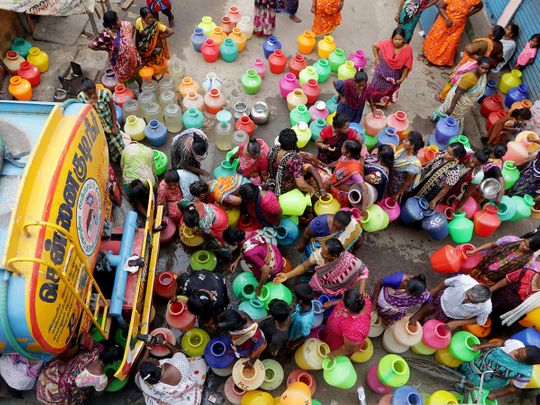
The White House Action Plan on Global Water Security by the Joe Biden administration says the water stress in South Asia creates challenges for farming, energy production, and access to clean water and sanitation. Pakistan recently gained global attention due to a massive flood, but it is also facing a serious water crisis, ranking 14 out of 17 extremely high-water-risk countries.
The largest country in the region, India, has 18 per cent of the world’s population but about 4 per cent of its freshwater resources. The Indian government policy think-tank Niti Ayog’s report in 2018 showed that 600 million Indians face high to extreme high-water stress, and 200,000 die every year due to lack of safe water.
By the end of this decade, India’s water demand is projected to be twice the available supply. In the last week of April, India released its first census report on the country’s water bodies. While reporting that most water bodies are privately-owned, many of which have become unusable, the census blames large population growth and urbanisation for the country’s increasing water scarcity.
Population and water scarcity
No doubt, population is growing in India as well as in South Asia. India has already surpassed China, and South Asia has become home to one-fourth of the world’s population. Like the rest of the developing world, South Asia is also experiencing urbanisation, not always due to economic growth.
However, blaming population growth for increasing water scarcity is an easy and lazy escape route for political leadership instead of taking responsibility for it. The internal freshwater availability per capita in South Asia is still as much as it is in South Korea. However, there is a large variation exists in water availability between countries in the South Asia region.
Despite the regular fearmongering, India still has more than 1,000 cubic metres per capita water availability. However, Bhutan has per capita freshwater above 100,000 cubic metres, Nepal nearly 7,000 cubic metres, Bangladesh about 634 cubic metres, and Pakistan 246 cubic metres. So, rather than passing the blame for growing water scarcity to the increasing population, it would be appropriate to explain how South Asia has failed to use its water efficiently and how it lacks a cooperative mindset to make the best possible use of its shared water.
Not only countries in the region have failed to cooperate over their shared water, but several states or provinces within these countries are also engaged in long-drawn water disputes.
If a region’s economy is primarily agricultural, the need for water is more. More than 90 per cent of South Asia’s water is used for agriculture. It is around 85 per cent in India, and for highly water-insecure countries like Pakistan and Bangladesh, it is about 95 per cent. When water is used for agriculture, it mostly evaporates, and only a small quantity returns to the water system for reuse, unlike the water used for industrial and municipal purposes. So, to make the best possible use of available water, an agricultural country should conserve and recycle water for irrigation.
In South Asia, the political leadership rarely dares to take decisive and practical measures for water conservation. Farmers are seen as vote banks, not primary water consumers. So, the water used for irrigation is highly unregulated and inefficient. The system to transport water from rivers to agricultural land is primitive and, in most cases, only one-fourth of water taken from the source reaches the destinations. South Asia’s irrigational canals are open and prone to leakages, and the countries are yet to move towards transporting water through concrete pipes.
Rapidly depleting water table
South Asia accounts for 40 per cent of the total groundwater withdrawal globally, and primarily uses water for agriculture. Without effective governance, South Asia is also witnessing overexploitation of groundwater, and the water table is depleting more quickly than socially and economically optimal.
Besides effectively regulating groundwater uses, South Asian countries must also focus on using recycled water for irrigation. A country like Israel recycles 90 per cent of its wastewater, and 85 per cent of the recycled water is used for agriculture. Water recycling is not only cost-effective and provides a dependable water supply, but it will also make South Asia less water insecure.
The other reason for increasing water scarcity in South Asia is the lack of cooperation among countries and states or provinces. Almost all of South Asia depends on freshwater supply from transboundary rivers. Despite high geographical interdependency, the politics of South Asia has not been conducive to creating effective cooperation for the best possible use of shared water resources.
India has an agreement to share the Indus River with Pakistan and another agreement with Bangladesh to share the Ganges River. These two agreements are primarily to divide these rivers’ water and lack any mechanism to make water use more effective and beneficial.
Many other regional transboundary rivers lack any bilateral agreement and have been subjected to unilateral exploitation. Not only countries in the region have failed to cooperate over their shared water, but several states or provinces within these countries are also engaged in long-drawn water disputes.
Climate change has made the water crisis in South Asia worse, but that has not persuaded political leaders to take necessary measures to use water efficiently and to refrain from using water as a political tool.









